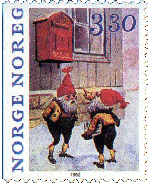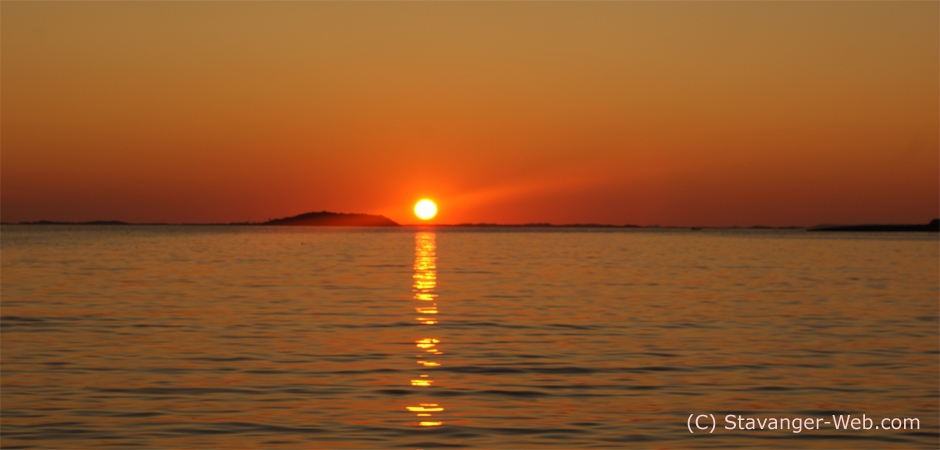På låven sitter nissen
The song being played is entitled : "På låven sitter nissen", The "nisse" is in the barn. The song is about a "nisse" eating his Christmas porridge - but the rats are dancing around annoying him. At last the "nisse" says he will go fetch the cat - and finally the rats give up.
På låven sitter nissen med sin julegrøt så god og søt, så god og søt.Han nikker, og han smiler, og han er så glad,for julegrøten vil han gjerne ha.
Men rundt omkring står alle de små rotter,og de skotter, og de skotter De vil så gjerne ha litt julegodter,
og de danse, danser rundt i ring.
Men nissen, se han truer med sin store skje: ``nei, bare se og kom av sted, for julegrøten min den vil jeg ha i fred,og ingen, ingen vil jeg dele med.``
Men rottene de hopper, og de danser, og de svinser, og de svanser, og klorer etter grøten og de danser, og de står om nissen tett i ring.
Men nissefar, han er en liten hissigpropp, og med sin kropp han gjør et hopp.
``Jeg henter katten hvis dere ikke holder opp! Når katten kommer, skal det nok bli stopp.``
Da løper alle rottene så bange,
ja, så bange,ja, så bange,
og de svinser, og de svanser noen ganger, og en, to, tre så er de vekk.
External Links:
How about a metal "licence plate" with Norwegian motives and Merry Christmas in Norwegian?
Or maybe you will enjoy reading about a Norwegian Christmas?
Or a 1000 piece wooden puzzle?
Christmas in Norway
These pages should give you a flavor of a Norwegian Christmas. They have been on the internet since 1997 and are one of the top results for the Google search "Christmas in Norway". If you miss anything, please contact us at postmaster "at" stavanger-web.com.
Christmas Trees in Norway
In Norway most everyone has either a spruce or a pine tree in their living room - decorated with white lights, tinsel, Norwegian flags and other ornaments for Christmas.
The children make paper baskets of shiny, colored paper. The baskets can be filled with candy or nuts. Chains made of colored paper are also very popular.
Colored lighting is becoming popular, but white lights are more like the candles they are supposed to represent. Christmas trees became common in Norway from around 1900. The custom of having Christmas trees is originally from Germany.
Before the presents are opened, many families dances in a ring around the Christmas tree while singing traditional Norwegian Christmas carols.
Christmas Tree Decorations
 It is a tradition in Norway to gather the family and make baskets of colorful paper to hang on the Christmas tree.
It is a tradition in Norway to gather the family and make baskets of colorful paper to hang on the Christmas tree.XXX
A Typical Norwegian Christmas Dinner
The most common Christmas dinners in Norway are "Pinnekjøtt" (steamed lamb ribs that have been salted and dried and sometimes smoked as well) and "Ribbe" (roasted pork ribs). Some people have fish in the form of cooked Cod or "Lutefisk" (stockfish in lye!). Turkey is catching on, but is more often served at New Years. Here is a recipe for a Pinnekjøtt dinner:
Pinnekjøtt
Pinnekjøtt has a good deal of bone fat, so it is best to allow about 500 g per person if it is served on its own; if it is served together with sausages, allow 350 g per person.
Separate the salted ribs from each other with a sharp knife and leave them in cold water overnight.
Go out in the woods and find enough fresh branches from a birch tree (finger thick) to cover the bottom of your pot. Remove the bark. Put the branches in your pot and and fill it with enough water to cover the branches. Place the ribs over the branches and cook until the meat loosens from the bone (apprx. 2 hours). Be careful so the pot doesn't cook dry - refill water as necessary.
Before serving, give the ribs a few minutes under the grill of your oven.
"Pinnekjøtt" is normally served with mashed kohlrabi (turnip) or rutabaga, boiled potatoes and mustard. Don't forget the aquavit and cold Christmas beer.
Mashed rutabaga
You will need approx. 1 kg rutabaga, water, pepper, salt, cooking juices from the "pinnekjøtt".
Peel and slice the rutabaga and cook it until tender in lightly salted water. Drain off the excess water. Pour 1/4 cup of cooking juice from the "pinnekjøtt", add salt and pepper and mash the rutabaga. You can use milk instead of cooking juices, then you should add a tablespoon of butter, too.
Rice Cream (creamy rice pudding/porridge)
3/4 cup whipping cream
2 tablespoons sugar
1 teaspoon vanilla extract
2 cups rice porridge
Serve with red fruit sauce on top. Rice Cream is often served with an almond hidden in it. The person who finds the almond gets a prize - usually a marzipan pig or a delicious Norwegian chocolate. Serves 4.
The Norwegian "Nisse"

The Norwegian "Nisse" is not like his American relative Santa Claus. The Norwegian "Nisse" differs from both Santa Claus and St. Nicholas. In modern Norway we have really two types of "nisser".
The name "Nisse" probably derives from St. Nicholas. But "nisser" - which are elves (or gnomes) are old figures which existed long before the birth of Christ. There are several types of "nisser" in Norway. The most known is the "Fjøsnisse" which is a "nisse" who takes care of the animals on the farms. The "Fjøsnisse" is very short and often bearded and lives in a barn or a stable. He wears clothes of wool and often has a red knitted hat. The "Fjøsnisse" often plays tricks on people. Sometimes he will scare people by blowing out the lights in the barn or he will scare the farm dog at night. You can hear the dogs bark! He can become very friendly with the people that live on the farm, but one should never forget to give him a large portion of porridge on Christmas Eve - or else he will play tricks for example move the animals around in the barn, braid the horses' mane and tail, and other tricks like that.........

Of course we also have a Christmas nisse (julenissen) which in most homes is more or less identical to Santa Claus. The "Julenisse" brings presents to all the nice children on Christmas Eve. He is not as shy as Santa though, since the "julenisse" delivers the presents himself. He does not come down the chimney in the middle of the night.
Santa Facts:
The Norwegian word for Santa Claus, "Julenisse" is a combination a Christian name (Nils = Nikolaus) and the hedonistic word for Christmas, Yule.
Carpenter Andersen
One of the most popular Norwegian Christmas Stories is "Carpenter Andersen" written by Alf Prøysen in 1971. The story has been shown on national TV and played in many local theaters cross the country.
"Once there was a father called Andersen, the Carpenter and he had a lot of children, like fathers usually do. One Christmas Eve, he slipped out of the house while his wife....."

Christmas Tree Facts:Did you know that the Christmas trees at Union Station, Washington D.C., Trafalgar Square in London and Edinburgh, Scotland are from Norway?
In 1947 the British authorities received a Christmas tree from Oslo as a special thanks for the help and support Britain gave to Norway and Norwegians during the occupation years from 1940 to 1945. Since then, the Christmas tree at Trafalgar Square has become an annual tradition.
|





